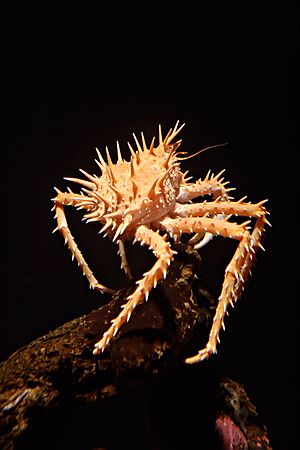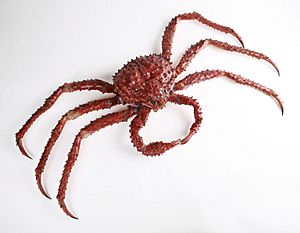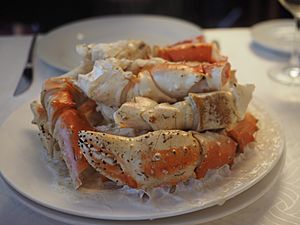King crab facts for kids
Quick facts for kids King crabs |
|
|---|---|
 |
|
| Paralithodes californiensis | |
| Scientific classification |
|
| Kingdom: | Animalia |
| Phylum: | Arthropoda |
| Subphylum: | Crustacea |
| Class: | Malacostraca |
| Order: | Decapoda |
| Suborder: | Pleocyemata |
| Infraorder: | Anomura |
| Superfamily: | Lithodoidea Samouelle, 1819 |
| Family: | Lithodidae Samouelle, 1819 |
| Genera | |
|
|
King crabs are a group of large, crab-like animals called crustaceans. They are mostly found in cold parts of the ocean. Many types of king crabs are caught and sold as food because they are big and their meat tastes good. The most well-known one is the red king crab (Paralithodes camtschaticus).
Scientists believe that king crabs actually came from ancestors that looked more like hermit crabs. This might seem strange, but there are clues in their bodies. For example, adult king crabs have a slightly uneven (asymmetrical) abdomen (their tail part, tucked under their body). This unevenness is thought to be a leftover from when their ancestors had to fit into spiral seashells, just like hermit crabs do today! This idea, where an animal changes its body shape to become more crab-like, is called carcinisation.
Contents
Why King Crabs Are a Special Group
Scientists like to group animals based on how they are related. King crabs were once grouped with hermit crabs in a large family called Paguroidea. However, most scientists now place king crabs in their own special group called Lithodoidea.
This change is a bit debated among scientists. Even though king crabs are now in their own group, many experts agree that they are still very closely related to pagurid hermit crabs. So, while they have their own group, it's important to remember their close family ties to hermit crabs.
Many Types of King Crabs
There are about 121 known species of king crabs, divided into 10 main groups, called genera. Some of these groups and a few interesting species include:
- Cryptolithodes
- Cryptolithodes sitchensis – known as the umbrella crab
- Cryptolithodes typicus – known as the butterfly crab
- Glyptolithodes
- Lithodes
- Lithodes aequispinus – called the golden king crab
- Lithodes couesi – called the scarlet king crab
- Lithodes maja – known as the Norway king crab
- Lithodes santolla – called the Chilean king crab
- Lopholithodes
- Lopholithodes foraminatus – known as the brown box crab
- Lopholithodes mandtii – called the Puget Sound king crab
- Neolithodes
- Paralithodes
- Paralithodes californiensis – called the California king crab
- Paralithodes camtschaticus – the famous red king crab
- Paralithodes platypus – the blue king crab
- Paralomis
- Phyllolithodes
- Phyllolithodes papillosus – known as the flatspine triangle crab or heart crab
- Rhinolithodes
- Rhinolithodes wosnessenskii – called the rhinoceros crab
- Sculptolithodes
About Glyptolithodes
The Glyptolithodes group of king crabs is mostly found in the Southern Hemisphere, which is unusual because most of its closest relatives live in the Northern Hemisphere. Its only species, Glyptolithodes cristatipes, was first placed in a different group called Rhinolithodes.
About Paralithodes
The red king crab (P. camtschaticus) and blue king crab (P. platypus) are very important for fishing in Alaska. However, their numbers have gone up and down over the last 25 years. Some fishing areas are even closed now to help the crab populations recover.
These two species are similar in size and shape. The main difference between where they live in the Bering Sea is their habitat. Red king crabs like shallow, muddy or sandy areas. Blue king crabs prefer deeper areas with rocks and gravel, such as around the Pribilof Islands, St. Matthew Island, St. Lawrence Island, and Diomede Islands.
Life Cycle and Reproduction
Red king crabs have a long brood cycle of about 11 to 12 months. Both red and blue king crabs have tiny larvae that float in the water. These larvae go through several stages before they become a non-feeding stage called a glaucothoe. This glaucothoe then searches for the right place on the ocean floor to settle down and grow into a young crab.
The Red King Crab

The red king crab, Paralithodes camtschaticus, is a very large species. Its shell can be up to 11 inches (28 cm) wide, and its legs can spread out to 6 feet (1.8 meters)! It naturally lives in the Bering Sea, near the Kamchatka Peninsula. It has also been brought to the Barents Sea and the European Arctic, where it is now thriving.
The Blue King Crab
The blue king crab, Paralithodes platypus, lives near St. Matthew Island, the Pribilof Islands, and the Diomede Islands in Alaska. There are also groups of them along the coasts of Japan and Russia. Blue king crabs from the Pribilof Islands are the biggest of all king crabs, sometimes weighing more than 18 pounds (8 kg).
King Crabs and Sea Pigs: A Special Friendship
Some species of king crabs, like Neolithodes diomedeae, have a unique relationship with a type of sea cucumber often called "sea pigs" (Scotoplanes). These king crabs can be found living on top of or underneath the sea pigs.
The sea pigs help protect the king crabs from predators, meaning other animals that might want to eat them. The sea pigs themselves are not harmed by having the crabs around. This type of relationship, where one animal benefits and the other is not affected, is called a commensal relationship. It's like a crab getting a free ride and some protection!
See also
 In Spanish: Litódidos para niños
In Spanish: Litódidos para niños



